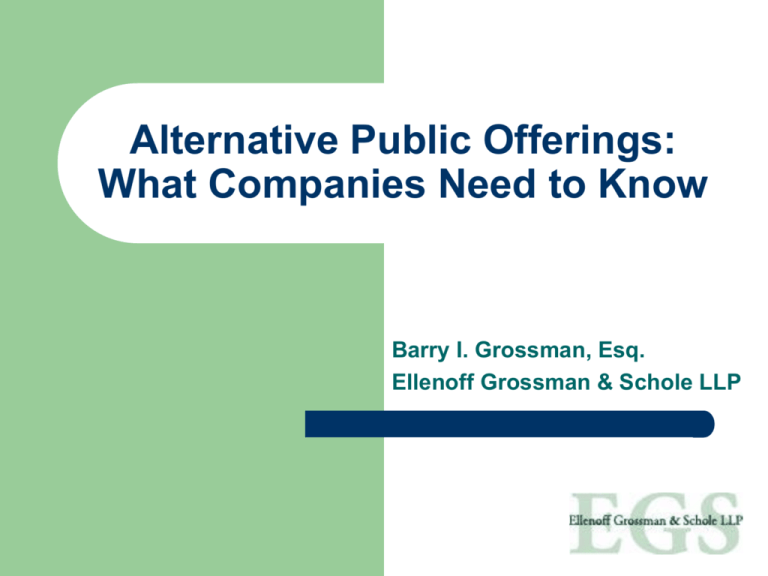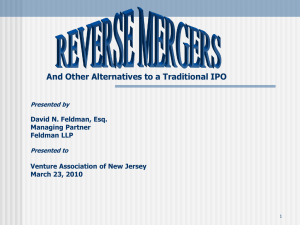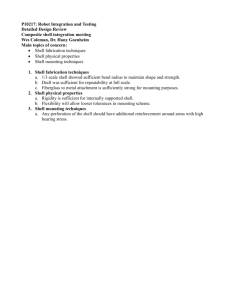Consummating a Reverse Merger - Ellenoff Grossman & Schole LLP
advertisement

Alternative Public Offerings: What Companies Need to Know Barry I. Grossman, Esq. Ellenoff Grossman & Schole LLP What is a Reverse Merger? Means of taking a private company into the public marketplace – In a reverse merger transaction, an existing public “shell company” acquires a private operating company What is a Reverse Merger? Cont. Avoids the time constraints, costs and disclosure requirements of traditional “going public” transactions, which include: – Initial Public Offering (IPO) Lengthy process Very expensive No certainty of success – – Self-Filings Self-underwriting without the assistance of a professional broker, firm or intermediary (requires an S-1 filing) No certainty of success – – Generally takes three to six months and requires the Company to make all selling efforts Special Purpose Acquisition Companies (SPACs) – Generally takes between six and nine months Newly formed corporation by prominent sponsor/ management team in a particular geographic or market niche for the purpose of raising capital in an IPO in anticipation of identifying and consummating a business combination Trust amount uncertain Form 10 Filing Does not provide shareholders a public float Usually not associated with raising money What is a Public Shell? A registrant with no or nominal operations and either no or nominal assets, assets consisting solely of cash and cash equivalents and generally no liabilities – The type of public shell company used can alter the process and timing of consummating a reverse merger Types of Public Shell Companies: – OTCBB Traded Shell – SEC Reporting but Non-Trading Shell (e.g. Form 10 Shell) – A company formed for the purpose of becoming a shell Is not listed or quoted but does comply with all ’34 Act reporting requirements Never had an operating business Non-Reporting Shell (Pink Sheet Shell) – An operating company that became a shell (loss of operations, sale of subsidiaries, bankruptcy, etc.) but continues to be listed or quoted on the OTCBB Is not listed or quoted and does not currently comply with ’34 Act reporting requirements Usually had an operating business but stopped reporting based on the number of shareholders of record Nasdaq/AMEX Shells Must requalify upon reverse merger Technically non-existent Steps to a Reverse Merger 1. 2. 3. 4. Public Shell creates a wholly-owned subsidiary Stockholders of Private Company A negotiate with the controlling shareholders of the Public Shell in order to merge with the subsidiary Private Company A merges into the subsidiary, with the Private Company surviving and shares of Public Shell issued to shareholders of Private Company A • Simultaneously with this transaction, the Public Shell can also conduct a PIPE (private placement) • A financing occurring simultaneously with (or immediately subsequent to) a reverse merger is referred to as an Alternative Public Offering Private Company A becomes a wholly-owned subsidiary of the Public Shell with the controlling stockholders of Private Company A (and the PIPE investors collectively) usually owning 90% or more of the Public Shell and the shareholders of the Public Shell owning the remainder • Private Company A’s management team becomes the directors and officers of the public company Private Company A Public Shell Trading on OTC.BB Wholly-Owned Private Public Shell Company A Sub OTCBB or Exchange Traded Shell Process – – – – – Due diligence, Due Diligence and more Due Diligence Negotiation of merger agreement (and financing terms if a simultaneous PIPE) Schedule 14f-1 (10 days prior to closing) if change in control of the Board Initial listing application for the combined entity (if an Exchange listed shell) “Super” Form 8-K (with full audited financials) due within 4 days of closing Timetable – Generally takes between 1-3 months Advantages – Full disclosure Exchanges require substantial disclosure to remain listed, making it easier to obtain and sift through all necessary disclosures – More investor friendly – Already public Due Diligence and Audit of Private Company More willing to invest because it is on an exchange (heightened governance and greater liquidity) The Shell will have a shareholder base, a symbol, a market maker, will be DTC eligible, and will have been trading Disadvantages – – – – Requires independent audit of combined company to be done at time of merger Prior history of the shell company may be “messy” Longest reverse merger process More Expensive (legal, accounting and price of shell) Form 10 Shell Process – – – – Timetable – Generally faster than exchange traded shells because the due diligence process is faster (Form 10 shells have fewer disclosures, documents and potential liabilities because they never had an operating business) Advantages – – – – Due diligence Negotiation of merger agreement (and financing terms if a simultaneous PIPE) Schedule 14f-1 (10 days prior to closing) “Super” Form 8-K (with full audited financials) due within 4 days of closing Quicker due diligence Fewer surprises Less expensive Ability to adjust capitalization table Disadvantages – – – – – Non-trading Not DTC eligible Potential prior history of shell promoters Smaller shareholder base No market maker Non-Reporting Shell Process – Due diligence – – – Generally 1 to 2 months, can be done quicker Advantages – – – Negotiation of a merger agreement and potential financing NO Schedule 14f-1 NO “Super” Form 8-K Timetable – Most complex because non-reporting Fast Fewer filings Shell is less expensive Disadvantages – No freely tradable shares available (plus one year holding period for restricted securities as per Rule 144(i) which applies to all shells) – More difficult due diligence process because there are no public filings Not investor friendly - lack of disclosure before and after the reverse merger Can only trade on the Pink Sheets until it becomes reporting Costly and time consuming to become a reporting company Least attractive to investors - no real liquidity, highly volatile stock price – – – – Reverse Merger Versus IPO Time – An IPO generally takes between six and nine months Major Events include: – – – – – A reverse merger generally takes less than three months Financial Audi No Registration Statement (Super 8-K) and therefore no SEC review Cost – – IPO has greater legal and accounting fees IPO requires an underwriter, unless self underwritten Financial Audit Preparation of the Registration Statement SEC review process – takes between three and nine months Stock exchange review process, if applying to list on a national exchange An alternative public offering generally includes a private placement with subsequent registration statement Disclosure – Registration Statement (i.e. Form S-1) versus “Super” Form 8-K Going public through an IPO requires the filing of a registration statement that is both costly and time consuming A reverse merger circumvents this filing requirement because the shares of the combined entity have already been registered by the shell The shell is only required to file a “Super” Form 8-K disclosing the merger, and all material information about the private company, including audited financial statements, but the 8-K is not subject to SEC review prior to the transaction – SEC controls the process Reverse Merger Process Phase One: Company Internal Preparation Phase Two: Due Diligence and Negotiation of Acquisition Terms Phase Three: Closing the Reverse Merger Phase One: Company Internal Preparation Often the most time consuming and complex piece of the Reverse Merger process Locate a Suitable Public Shell U.S. Securities Counsel and qualified Independent Auditors Financial Staff – Organize a team of financial experts to support public audits and filings Financial Audits – – Obtain SEC qualified audited financial statements of both the private company and the shell for at least the last two fiscal years or the date of organization if less than two years The financial statements of the private company will need to be consolidated with the public company’s financial statements prior to closing This process can take six months if the company and shell do not provided proper financial statements but generally takes at least two to three months Assuming that the Company’s and the shell’s current and existing financial statements are IFRS or GAAP compliant, and the auditors only need to reconcile the financial statements for US GAAP compliance, Phase One should take no longer than three months. Note: Phase Two should occur while the audit portion of Phase One is being conducted and should be completed prior to the audit’s completion. Phase Two: Due Diligence and Negotiation of Acquisition Terms Letter of Intent – – – Private company and public shell enter into a letter of intent Private company and investors negotiate a letter of intent for financing, if applicable The major terms of the reverse merger are negotiated at this point (i.e. percentage ownership, board membership, management of the company, ability to sell stock, representations and warranties, claw backs, etc.) as well as any simultaneous financing component Due Diligence – Gather due diligence on the Public Company and its shareholders (number of shareholders, round lot shareholders) Digest all material information – Before closing, the private company must make sure to conduct thorough due diligence on the shell – – – This process can take two to four weeks Clean Shell v. Messy Shell v. Dirty Shell Review of all public filings and other material documents; litigation/background checks Look to make sure that the shell: Does not have any potential/unforeseen liabilities related to past businesses or management Clarity as to number of shareholders Has been compliant in regulatory filing and listing obligations Can, without undue difficulty or delay, consummate the reverse merger transaction Is DTC eligible Has a capitalization structure that allows for a sufficient amount of shares to be issued Shareholder base allows the target to take control It will take about two weeks to negotiate the letter of intent and another two to four weeks to complete due diligence, which should be done simultaneously. Phase Three: Closing the Reverse Merger Transaction Documentation – – Drafting begins immediately after the letter of intent is signed and usually takes two to four weeks to complete Transaction documents include: Super 8-K Preparation – – – Share exchange agreement Financing documents (if applicable) Super 8-K Board and Shareholder consents Super 8-K involves comprehensive disclosures regarding the prospective acquisition and the change of control, including all information required in a Form 10 (i.e. information regarding the Company’s business, material agreements, risk factors and directors and officers), MD&A, and two years of audited financial statements Must be filed within four days of closing of the reverse merger Begin drafting this document after the letter of intent is signed, but cannot be finalized without the audit and definitive documents Stock Certificates – Issue and distribute stock certificates The timetable for Phases One through Three takes approximately one to three months. Listing Requirements The SEC recently approved new rules of the three major U.S. listing markets (NYSE, NYSE Amex, NASDAQ) that toughen the standards that companies going public through a reverse merger must meet to become listed on those exchanges – One Year Seasoning Period The equity securities of the reverse merger company must have traded in the U.S. over-the-counter market, on another national exchange, or a regulated foreign exchange following the consummation of the reverse merger for at least one year prior to applying for listing Timing also dependent on 10-K filing: A company must file at least one annual report which contains audited financial statements for full fiscal year which commences after filing of Super 8-K prior to being approved for listing. – – Ex: If a Company with a 12/31 fiscal year end consummates a reverse merger in January and files its 10-K in March, the Company will not be able to list until the Company files its next 10-K. These rules are in response to increased allegations of fraud in the preparation of financial statements, particularly with respect to Chinese reverse mergers Minimum Trading Price The reverse merger company must have maintained a minimum closing price of between $2 and $4 (depending on the exchange) for no less than 30 of the most recent 60 trading days Listing Requirements, Cont. – Disclosure Requirement – Exemptions: – NASDAQ – According to NASDAQ Rule 5110(c), a company must file “all required information about the reverse merger transaction with the SEC or other regulatory authority, including audited financials for the combined entity” NYSE/NYSE Amex – Form 8-K and Form 10-equivalent (or Form 20-F for foreign issuer) information as well as required audited financials Listing in connection with an initial firm commitment underwritten public offering of at least $40M (occurring concurrently or after the reverse merger); or Satisfied the one-year trading requirement and filed with the SEC at least four annual reports (must have all required audited financial statements) while satisfying all other applicable requirements for listing, including the minimum price requirement and the requirement not to be delinquent with SEC filings Possible Form 10 Exception If the privately held company files a Form 10 registration statement prior to the reverse merger, the merged entity can avoid the one year seasoning period SEC Activity on Reverse Mergers Amendments to Rule 144 – – Permits holders of shell shares to sell under Rule 144 commencing 12 months after “Super” Form 8-K with Form 10 Information Evergreen Rule for Companies that were at any time Shell Companies – Non-Shell Companies The shareholders of a company that was at one point a shell cannot sell their shares under Rule 144 unless the company is current in its regular SEC filings for the 12 months prior to the sale The non-affiliated shareholders of non-shell company can sell their shares under Rule 144 after holding the shares for six months if current in SEC filings; the company must remain current in its filings for the next six months for sales under Rule 144 After the one year holding period, unlimited resales under Rule 144 are permitted SEC Probe of China-based Companies – December 2010 – – – – – – SEC Identifies Several Small Audit Firms Outsourcing Work to Local Chinese Audit Firms Focus on Reverse Merger Transactions Follows PCAOB Audit Practice Alert in July 2010 U.S. Audit Firm Sanctioned for Signing Off on Fraudulent Financial Statement of Chinese Company Failure to Exercise Professional Skepticism and Due Professional Care 81 of 246 Reverse Mergers in 2010 Involved Chinese Companies SEC Activity on Reverse Mergers (Cont’d) Speech by SEC Commissioner – Louis A. Aguilar – Foreign Companies Abusing U.S. Capital Formation Process – April 2011 – – – – Since January 2007 – 600 “Backdoor” Registrations, over 150 of which have been Chinese Companies There is Growing Accounting Deficiencies and Outright Fraud SEC has set up Internal Task Force to Investigate Fraud with Emphasis on Reverse Mergers Greater Enforcement by SEC Why go public: Advantages Increased liquidity more attractive to top quality directors, officers and consultants – Company can become more widely known Increased access to capital - larger pool of potential investors for debt or equity Known market value for company – Ability for shareholders to “cash out” Usually a premium to private valuation Shares can be used for acquisitions and employee compensation Why go public: Disadvantages Reporting requirements pursuant to the Securities Exchange Act of 1934 – Sarbanes-Oxley reporting requirements Increased liability – Legal, accounting, filing Decrease in managerial flexibility – – Risk of litigation Increased costs – Required to file annual, quarterly and periodic reports (disclosure issues) Shareholder approval of actions Independent board members Management ability to focus on business rather than stock price Contact Information Ellenoff Grossman & Schole LLP is a New York City-based law firm comprised of almost 60 professionals (30 Securities Lawyers), offering its clients legal services in a broad range of business related matters. Founded in 1992, the Firm specializes in many areas of commercial law, including corporate and securities, '33 Act and '34 Act representation, reverse mergers, PIPEs, SPACs, going private and mergers and acquisitions. We represent nearly 50 public companies in various industries: biotechnology, medical devices, information technology, financial services, shipping, alternative energy, consumer products and business services throughout the world – including Greece, China, India and Israel; Hedge Fund Formation and Regulation; Broker-Dealer Regulation, transactional Real Estate (leasing, financing and buy/sell; domestic corporate Taxation and general commercial Litigation). Barry I. Grossman Ellenoff Grossman & Schole LLP 150 East 42nd Street, New York, NY 10017 (212) 370-1300 bigrossman@egsllp.com; This presentation is for informational purposes and does not contain or convey legal advice. The information herein should not be used or relied upon in regard to any particular facts or circumstances without first consulting a lawyer





![[#IDENTITYCONNECTORS-299] SHELL scripting](http://s3.studylib.net/store/data/007586759_2-6776383e22ea2e271e255b7e6702f077-300x300.png)

